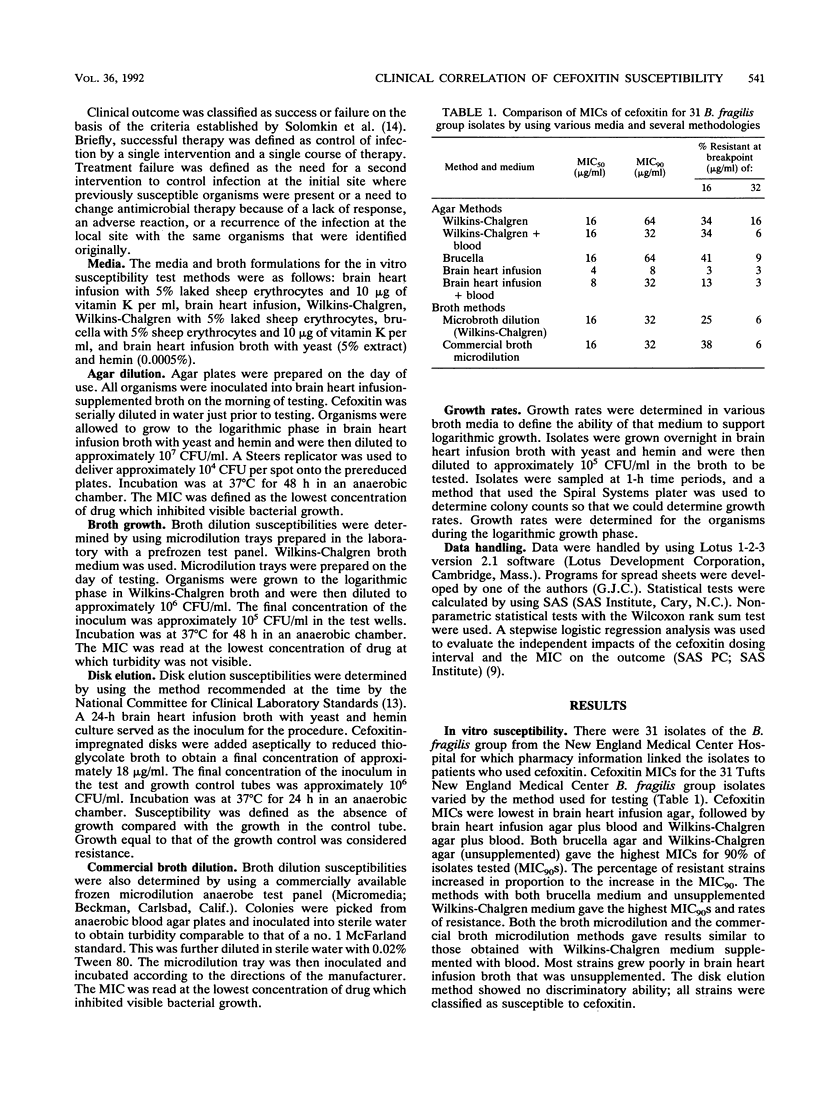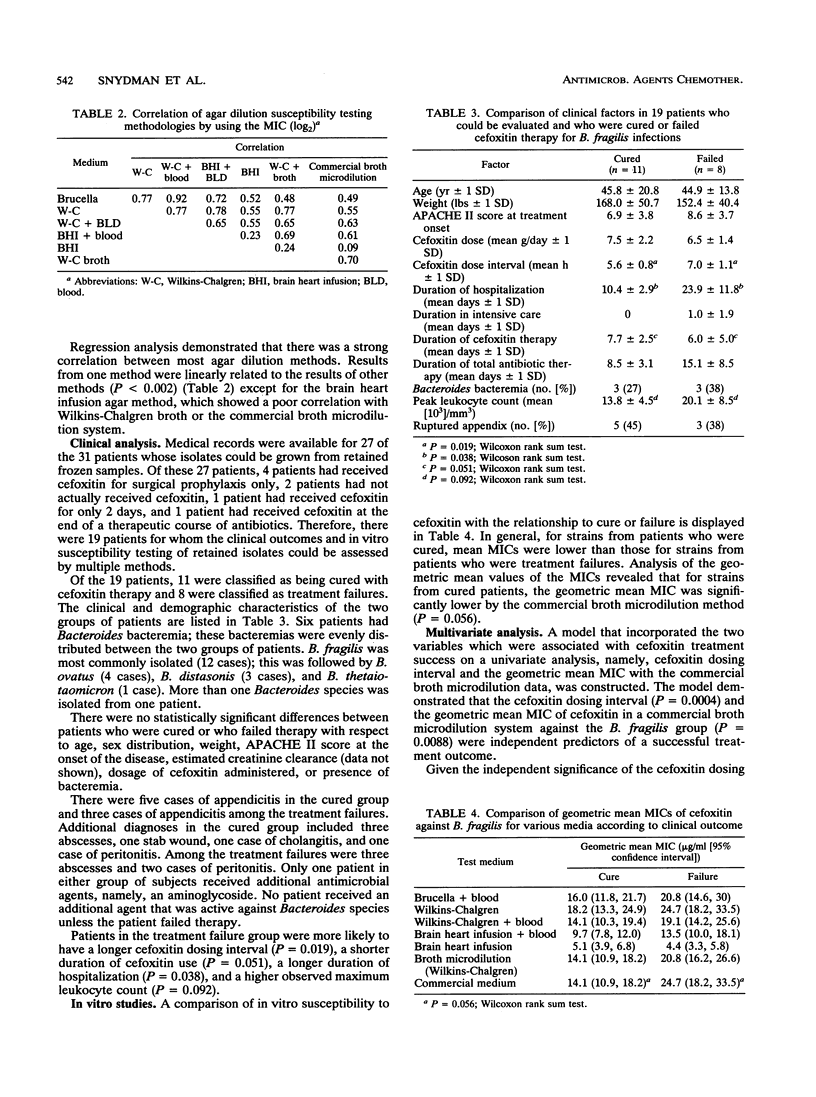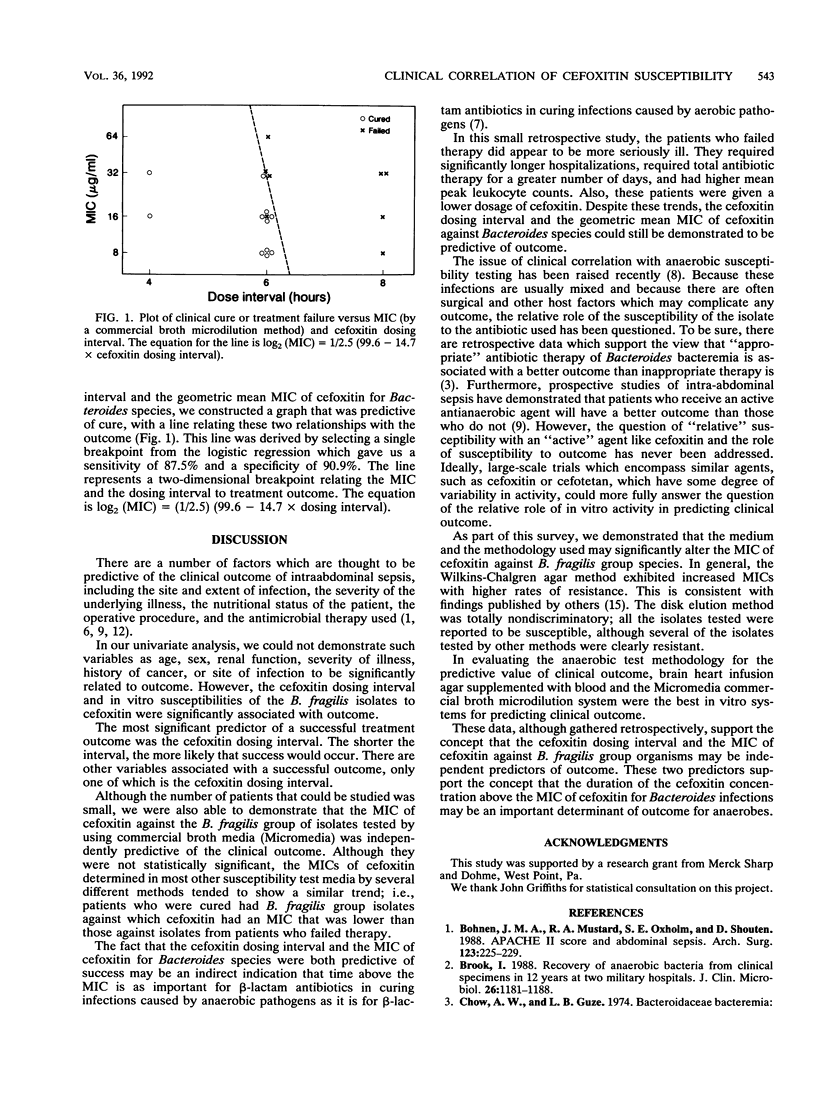Abstract
There is limited information regarding the correlation of anaerobic susceptibility testing and outcome in the treatment of Bacteroides fragilis infections. We retrospectively analyzed the clinical outcomes of B. fragilis infections in patients treated with cefoxitin; the analysis was blinded for susceptibility results. Isolates of B. fragilis were tested by multiple agar dilution methods, disk elution, and commercial broth microdilution methods. Of 19 patients analyzed, 11 were cured and 8 were treatment failures. No significant differences existed between the groups with respect to age, sex distribution, weight, APACHE II score, dose of cefoxitin, or bacteremia. Failure was associated with a longer cefoxitin dosing interval (P = 0.019), a longer duration of hospitalization (P = 0.038), and decreased duration of cefoxitin treatment (P = 0.05). Four agar dilution systems (brucella plus blood, Wilkins-Chalgren, Wilkins-Chalgren plus blood, brain heart infusion plus blood) and two broth systems (Wilkins-Chalgren microdilution and a commercial system [Micromedia; Beckman, Carlsbad, Calif.]) all demonstrated lower geometric mean MICs for isolates from the group of patients that could be cured. Only the commercial broth microdilution medium (Micromedia) demonstrated a significantly reduced geometric mean MIC (P = 0.056). By using a logistic regression analysis, the shorter cefoxitin dosing interval (P = 0.0004) and the lower geometric mean MIC (P = 0.0088) in the commercial broth microdilution system were shown to be independent predictors of treatment success. These data suggest that the time that the concentration of cefoxitin is over the MIC for B. fragilis may be an important predictor of treatment success.
Full text
PDF




Selected References
These references are in PubMed. This may not be the complete list of references from this article.
- Bohnen J. M., Mustard R. A., Oxholm S. E., Schouten B. D. APACHE II score and abdominal sepsis. A prospective study. Arch Surg. 1988 Feb;123(2):225–229. doi: 10.1001/archsurg.1988.01400260113014. [DOI] [PubMed] [Google Scholar]
- Brook I. Recovery of anaerobic bacteria from clinical specimens in 12 years at two military hospitals. J Clin Microbiol. 1988 Jun;26(6):1181–1188. doi: 10.1128/jcm.26.6.1181-1188.1988. [DOI] [PMC free article] [PubMed] [Google Scholar]
- Cornick N. A., Cuchural G. J., Jr, Snydman D. R., Jacobus N. V., Iannini P., Hill G., Cleary T., O'Keefe J. P., Pierson C., Finegold S. M. The antimicrobial susceptibility patterns of the Bacteroides fragilis group in the United States, 1987. J Antimicrob Chemother. 1990 Jun;25(6):1011–1019. doi: 10.1093/jac/25.6.1011. [DOI] [PubMed] [Google Scholar]
- Cuchural G. J., Jr, Tally F. P., Jacobus N. V., Aldridge K., Cleary T., Finegold S. M., Hill G., Iannini P., O'Keefe J. P., Pierson C. Susceptibility of the Bacteroides fragilis group in the United States: analysis by site of isolation. Antimicrob Agents Chemother. 1988 May;32(5):717–722. doi: 10.1128/aac.32.5.717. [DOI] [PMC free article] [PubMed] [Google Scholar]
- Dellinger E. P., Wertz M. J., Meakins J. L., Solomkin J. S., Allo M. D., Howard R. J., Simmons R. L. Surgical infection stratification system for intra-abdominal infection. Multicenter trial. Arch Surg. 1985 Jan;120(1):21–29. doi: 10.1001/archsurg.1985.01390250015003. [DOI] [PubMed] [Google Scholar]
- Drusano G. L. Role of pharmacokinetics in the outcome of infections. Antimicrob Agents Chemother. 1988 Mar;32(3):289–297. doi: 10.1128/aac.32.3.289. [DOI] [PMC free article] [PubMed] [Google Scholar]
- Heseltine P. N., Yellin A. E., Appleman M. D., Gill M. A., Chenella F. C., Kern J. W., Berne T. V. Perforated and gangrenous appendicitis: an analysis of antibiotic failures. J Infect Dis. 1983 Aug;148(2):322–329. doi: 10.1093/infdis/148.2.322. [DOI] [PubMed] [Google Scholar]
- Knaus W. A., Draper E. A., Wagner D. P., Zimmerman J. E. An evaluation of outcome from intensive care in major medical centers. Ann Intern Med. 1986 Mar;104(3):410–418. doi: 10.7326/0003-4819-104-3-410. [DOI] [PubMed] [Google Scholar]
- Lennard E. S., Minshew B. H., Dellinger E. P., Wertz M. J., Heimbach D. M., Counts G. W., Schoenknecht F. D., Coyle M. B. Stratified outcome comparison of clindamycin-gentamicin vs chloramphenicol-gentamicin for treatment of intra-abdominal sepsis. Arch Surg. 1985 Aug;120(8):889–898. doi: 10.1001/archsurg.1985.01390320013002. [DOI] [PubMed] [Google Scholar]
- Solomkin J. S., Dellinger E. P., Christou N. V., Mason A. D., Jr Design and conduct of antibiotic trials. A report of the Scientific Studies Committee of the Surgical Infection Society. Arch Surg. 1987 Feb;122(2):158–164. doi: 10.1001/archsurg.1987.01400140040004. [DOI] [PubMed] [Google Scholar]
- Wexler H. M., Reeves D., Finegold S. M. Antibiotic susceptibility testing of anaerobic organisms using the agar dilution method: comparison of three techniques. Clin Ther. 1988;10(6):747–760. [PubMed] [Google Scholar]


